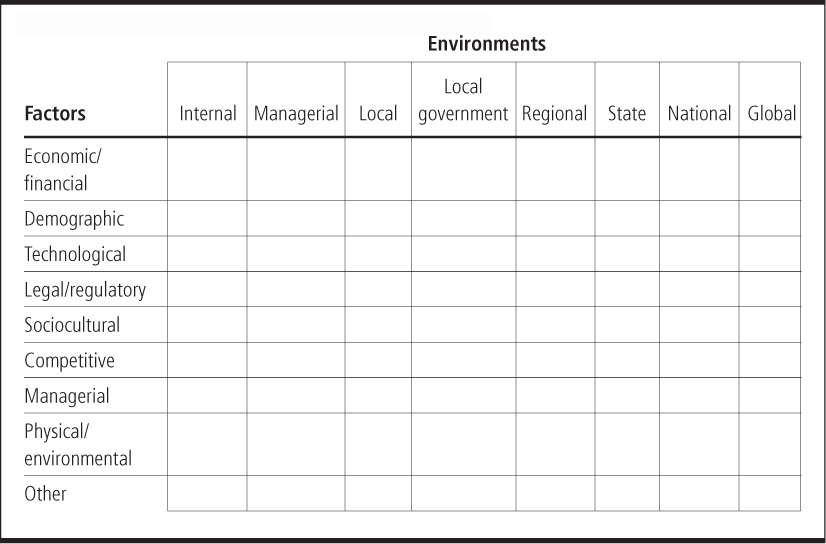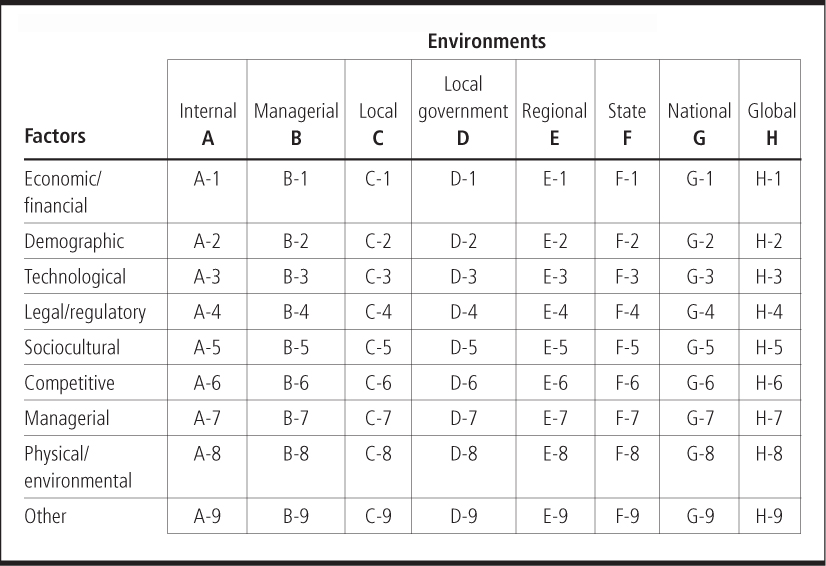6
Environmental Scan
Every local government group working on a strategic plan needs to carry out an environmental scan that considers the various environments that make an impact on the jurisdiction. Local governments operate within numerous environments. In each of these operating environments, local government managers must attempt to describe what will happen during the next several years. Only after they form these descriptions can they devise strategies.
External environment
Of all the areas that affect strategic planning, the area of formal jurisdiction is the one that will most obviously affect the success of the plan. Happenings within the jurisdiction are only one part of what affects a jurisdiction, however. Strategic planners need to look outside their borders and also consider factors in the surrounding areas. What neighbors do can affect local operations, and the region needs to be considered, too.
Local governments are affected by what happens at the state and national levels, not only in terms of unfunded mandates and direct appropriations but also in terms of general political and legislative directions. Border communities are more affected than others by neighboring states within a region and by the policies and actions of other countries; therefore, they need to look closely at factors in those environments. Even states that do not share a border with Mexico or Canada or face a coast may be influenced by what happens in other countries; for example, international air service affects many states, whether or not they have an international border.
Internal environment
The internal environment is the local government itself. Are the elected officials and staff effective? Are they receptive to new ideas? Is the local government properly structured and staffed?
The internal scan is often more difficult for planners to complete effectively than are the scans of the external environments. People outside the government are often unfamiliar with the inner workings of the local government, and those who are inside are too close to situations to view them with a fresh and unbiased eye. Further, many internal situations require qualitative assessments that are more difficult to evaluate than the often more factual issues in the external environments. Still, the effort is important because, ultimately, the plan will be implemented to a large extent by professionals on the local government staff.
Another consideration important to the scan of the internal environment is that, although the local government managers might believe that they are effective, efficient, and responsive, the perception in the community might be otherwise. It is the perceptions of the local government that will drive the community at large to support the strategic plan and help implement it. Communities often use surveys to assess what people believe to be the strengths and weaknesses of the staff; Appendix A provides the results of a survey of citizen opinion conducted in Winston-Salem, North Carolina.
Management environment
The environment of local government management as a profession is also important. What is new in the practice of municipal management? What lessons have been learned in other communities that can be instructive in other jurisdictions?
The strategic planning committee attempts to anticipate as many of the changes that will occur in its environment as possible. Of course, much cannot be forecast. No one anticipated the events of September 11, 2001, and the impact they would have on local governments. Other events, including natural disasters or business location decisions, can have unanticipated consequences for localities.
Notwithstanding the completely unexpected—for which one can only plan in the most general way—professional managers and planners at the local government level can draw upon their collective experiences and design a fairly accurate picture of what is coming. A planning committee with a great diversity of experiences and perspectives is thus a valuable component of the planning committee’s membership.
Environmental scanning matrix
In each of the relevant environments, some factors obviously deserve consideration: legislation and regulations; political and policy shifts; and economic, demographic, sociocultural factors. Each community should also consider whether additional factors characterize local circumstances.
To ensure that the planning committee considers all of the possible changes to the many factors within each of the various environments, it is helpful to construct an environmental scanning matrix to guide study and discussion and to lead to a comprehensive view of the future for the community and its government. The matrix is a tool best used in a flexible way to set an agenda without controlling the discussion. A sample environmental scanning matrix is illustrated in Table 6-1.
It is often helpful to identify, for each of the resulting cells, a number that can serve as a reference point during research and discussion. This can be accomplished by assigning a letter to each environment and a number to each factor, as is illustrated in the example in Table 6-2.
Table 6-1 Sample environmental scanning matrix

Table 6-2 Sample environmental scanning matrix with cells identified

This scanning matrix can be used effectively in several ways. One means of facilitating the discussions of members of the planning committee is to provide background material for their preparation before the first meeting. The scan can be used to ensure that all relevant information is made available and to classify it for the members.
Second, experts in the group can be assigned to clarify each of the relevant cells. Each person recognized as an expert on a specific topic can be designated as the lead member in preparing the group and facilitating its discussion of that topic.
The scan can also be helpful in facilitating the discussions of the group when it arrives at that point in the process. Planners in St. Louis County, Missouri, took this approach. Expert task forces were formed to “develop the specific outcomes and strategies to address the four critical issues.” The four task forces, one focusing on each strategic issue, comprised internal and external experts with considerable knowledge of their specific issue. Task force participants included county officials, municipal officials, regional and civic leaders, and private sector representatives.
The environmental scanning matrix is a tool for discussants, but it must be used flexibly. If the group is discussing cell A-5, for example, and a point is raised that seems to fit cell C-5 instead, it needs to be noted and included when it comes up in the conversation. The fact that it is not in the “best” or “correct” cell is irrelevant because all the conclusions will be integrated at a later point in the process. The strategic planning matrix is only a tool to make sure that all relevant topics are considered.
In the course of discussion, local planners will identify the points requiring discussion for each of the cells in the matrix. Although it is unlikely that two local governments will have exactly the same points to cover, there are some likely constants. Appendix B lists some areas that are likely to be appropriate for most communities.
The detailed analysis and discussions that will later serve as the foundation of the strategic plan now have an outline. Using the environmental scanning matrix, the planning committee will begin to see goals and objectives take form clearly and logically. Appendix C reproduces an excellent example of an environmental scan from Winston-Salem, North Carolina.
SWOT analysis
When the environmental scan has been completed, the conclusions can be categorized in the form of a SWOT analysis—the strengths and weaknesses of the community and its local government as well as the potential opportunities and threats that were discussed. Strategic planners can then develop goals and objectives that address the weaknesses, take maximum advantage of the strengths, and minimize or eliminate the presumed threats while they prepare to take advantage of likely opportunities.
Examples of how three jurisdictions—Gratiot County, Michigan; Wilcox, Arizona; and Franklin County and Columbus, Ohio—documented their SWOT analyses are in Appendix D.